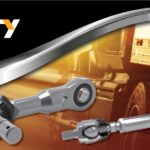In the realm of construction equipment, bearings are fundamental components that enable machinery to operate efficiently under heavy loads and demanding conditions. They reduce friction, support substantial weights, and facilitate smooth rotational and oscillatory movements. Understanding the specific types of bearings used and their applications within construction machinery is crucial for optimizing performance and ensuring durability.
COMMON TYPES OF BEARINGS IN CONSTRUCTION EQUIPMENT
Ball Bearings
These bearings feature two concentric rings that rotate around each other on a series of steel balls, minimizing friction. They are commonly found in motors, transmissions, and wheels, where they handle both radial and axial loads. Their smooth rolling action allows for reduced wear and tear, ensuring longer machine life.
Roller Bearings: RNN and Cylindrical Roller Bearings
Cylindrical roller bearings are designed to carry heavy radial loads, these bearings distribute the load over a larger area due to their cylindrical rollers. They are typically used in applications like crane booms and gearboxes. Their ability to withstand significant radial forces makes them ideal for machinery subjected to continuous operation under high stress.
RNN – or planetary gear bearings – are found in gearboxes and track drives. Full complement bearings need only a small amount of radial space and provide high load capacity.
Spherical Roller Bearings
Capable of accommodating high radial loads and moderate axial loads, these bearings are suitable for applications where misalignment and heavy loads are prevalent, providing robust performance in harsh operating conditions. Their self-aligning capability allows for better handling of misalignment, which is common in construction equipment due to uneven terrains.
Bushings
Suitable for applications where space is limited self-lubricated bushings and metal bushings are commonly used in compact machinery components like hydraulic cylinders and gear pumps. Their small size and high strength make them perfect for components where efficiency and space-saving are critical.
Linkages
Linkages connect different components, allowing for controlled movement and force transmission. These linkages are commonly found in excavators, backhoes, loaders, and bulldozers, where they help translate hydraulic power into precise mechanical motion. For example, the bucket linkage in an excavator consists of arms, pivot points, and joints that enable the bucket to dig, lift, and dump materials with accuracy. Similarly, steering linkages in loaders and articulated dump trucks ensure smooth and responsive maneuvering. High-quality bearings and bushings are critical within these linkages to reduce friction, absorb shock loads, and extend the lifespan of the equipment. Properly designed and maintained linkages improve efficiency, reduce wear on other components, and enhance the overall performance of construction machinery in demanding environments.
HOW BEARINGS ENABLE CONSTRUCTION EQUIPMENT TO TAKE HEAVY LOADS
Bearings in construction equipment must support extreme loads, high shock forces, and continuous operation. The ability to withstand these conditions comes from several designs:
- High Load Capacity: Construction equipment bearings are designed with materials and structures that allow them to carry immense loads without failure. For example, cylindrical and spherical roller bearings distribute weight across multiple points, reducing localized stress.
- Durability and Wear Resistance: Bearings used in construction machinery are manufactured with high-quality steel and special coatings that resist wear, corrosion, and contamination. Many bearings feature heat-treated surfaces to enhance their strength and longevity.
- Self-Aligning Properties: Certain bearings, such as spherical roller bearings, compensate for shaft misalignment, a common issue in construction machinery due to uneven terrain and heavy vibrations. This feature ensures smooth operation and prevents premature failures.
- Effective Lubrication Systems: Proper lubrication is essential for reducing friction and heat generation. Many modern bearings incorporate advanced lubrication technologies, such as sealed or pre-lubricated designs, to ensure long-lasting performance in extreme conditions.
- Shock Absorption: Construction machinery is frequently subjected to high-impact loads. Bearings with specialized cage designs and materials help absorb shocks, preventing damage to both the bearings and surrounding components.
- Sealing Against Contaminants: Construction sites are often dusty and filled with debris, which can compromise bearing performance. Sealed and shielded bearings prevent contaminants from entering, ensuring smooth and reliable operation.
- Reduced Downtime and Maintenance Costs: By using high-quality bearings, construction companies can reduce maintenance costs and increase equipment uptime. Well-designed bearings minimize the risk of breakdowns, allowing machinery to stay operational for longer periods.
Bearings are integral to the functionality and durability of construction equipment, enabling machines to handle heavy loads efficiently. By selecting appropriate bearing types and ensuring high-quality manufacturing, equipment manufacturers can enhance performance, reduce maintenance needs, and extend the operational life of their machinery. Understanding the specific applications of each bearing type within construction equipment is essential for optimizing machinery performance and ensuring safety on construction sites.
With the continued advancements in bearing technology, construction equipment will continue to evolve, becoming more efficient, durable, and capable of handling the demanding tasks required on job sites. Ensuring the proper selection and maintenance of bearings will help construction companies maximize productivity while reducing downtime and repair costs


